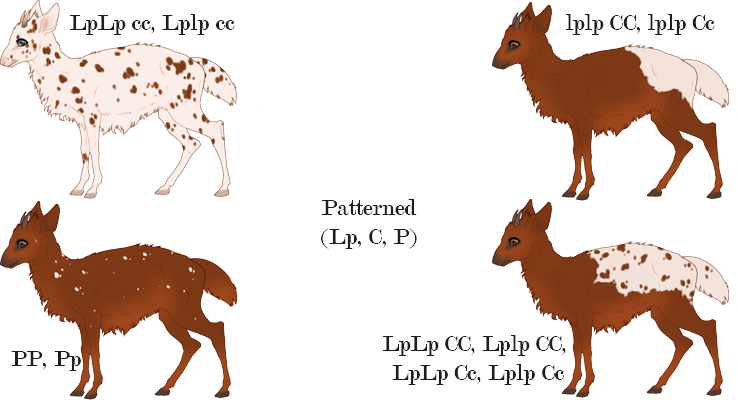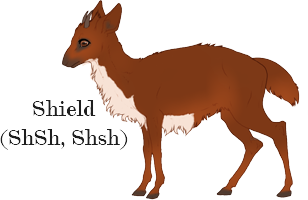If you need to make more than one topic for your adoptables, you can put the extra topics in here. Please read stickies for more information
 by Dia. » Wed Dec 30, 2020 6:19 am
by Dia. » Wed Dec 30, 2020 6:19 am
Silky Dik-Diks V2
|
main | myo | information |
discord | artist search |
---
Silky Dik-Dik genetics are heavily based on equine genetics.
Breeding outcomes can be predicted using a punnett square. c:
Tail Genetics
Long Tail (mm)
Short Tail (MM, Mm)
Tailless (M?M?)
5% chance to pass when paired with short tail or tailless ONLY.
When paired with long tail, offspring will have short tail
Eye Color
Browns (Chocolate, Browns, Sepia, Gold) - Very Common
Greens (Hazel, Green, Olive) - Uncommon, Most Commonly Seen with Cream/Dilutions
Blue (Dark Blue, Teal, Light Blue) - Uncommon, only occurs with a carried white marking gene
Heterochromia - May be present with painted genes/Caused by mutations
White Markings
While there are specific genes for specific white markings, silkies may have random white markings. These markings can occur on the legs, tail tip, and face.
Last edited by
Dia. on Wed Dec 30, 2020 7:04 am, edited 1 time in total.
-

Dia.
- FanArt Archivist
-
- Posts: 26460
- Joined: Mon Feb 02, 2009 4:31 pm
- My pets
- My items
- My wishlist
- My gallery
- My scenes
- My dressups
- Trade with me
 by Dia. » Wed Dec 30, 2020 6:31 am
by Dia. » Wed Dec 30, 2020 6:31 am
Base Genetics
ExtensionRed (ee)
Compare to chestnut horses. There is no black pigment in the hairs and there is a large spectrum of red coat colors. Red silkies have dark skin and dark gray or brown horns and hooves.
Black (Ee, EE)
Compare to black horses. Black silkies have dark skin and dark horns and hooves.
AgoutiBay (AA, Aa, AAs, AAw)
Compare to bay horses. The black pigment is restricted to points. Bays may be seen in a large range of shades, similar to red. It has no effect on (ee) red coats, as there is no black pigmentation in the hairs. Bay silkies have dark skin and dark horns and hooves. Bay(A) is dominant over the other agoutis.
Seal bay(AsAs, Asa, AsAw)
Compare to seal bay horses. The coat is dark, but reddish coloration shows in areas with thin hair. It has no effect on (ee) red because of the lack of black pigment in red coats. Seal bay silkies have dark skin and dark horns and hooves. Seal(As) is dominant over wild.
Wild bay (AwAw, Awa)
Compare to wild bay horses. Wild bay is the same as bay, but the black points are significantly smaller. It has no affect on (ee) red because of the lack of black pigment. Wild bay silkies have dark skin and dark horns and hooves. Wild(Aw) is recessive to all agoutis.
Last edited by
Dia. on Wed Dec 30, 2020 7:26 am, edited 1 time in total.
-

Dia.
- FanArt Archivist
-
- Posts: 26460
- Joined: Mon Feb 02, 2009 4:31 pm
- My pets
- My items
- My wishlist
- My gallery
- My scenes
- My dressups
- Trade with me
 by Dia. » Wed Dec 30, 2020 6:32 am
by Dia. » Wed Dec 30, 2020 6:32 am
Dilutions and Modifiers
DilutionDun (DD, Dd)
Dun dilutes the base color while leaving the points dark and usually adds at least one dun factor including striping on the legs and/or barring over the topline. The striping can cover the silky's legs, or be localized around the joints. When barring occurs, it always occurs over the shoulder and additional bars may be added towards the head or hind end. The examples shown are dun over red, black, and bay, but dun is not limited to these colors. Skin and horns and hooves are not affected by dun.
Cream (CrCr, Crcr)
Cream drastically dilutes the base color so that the points fade as well. Skin tends to have a pinkish color and the horns and hooves are lighter. The skin may also be mottled or freckled and homozygous (CrCr) creams may sometimes "shimmer". Homozygous creams will often be lighter than heterozygous (Crcr) creams. The examples shown are cream over red, black and bay, but it is not limited to these colors.
Soft (ss)
Soft is a recessive trait that dilutes underfur, causing the face, chest, belly, legs, and tail to be very pale. Horns and hooves are lightened by soft, but the skin is unaffected. Soft only affects red and black. Other colored silkies may carry the gene, but will not express it. Soft does not effect markings, only the base color

Sooty (stysty)
Sooty is a recessive gene that causes darkening over the topline.Dappling of thinner and shorter hair is also possible. It can occur on any color, but is hardly noticeable on cream and it will not cover markings. Sooty may cause horns to appear darker, but hooves and horns are generally unaffected.
Fade (ff)
Fade is a recessive gene that causes fading over the topline, opposite of sooty. It may be mistaken for fading caused by sunshine. Like sooty, slight dappling of thinner and shorter hair is possible. It can occur on any color, but is hardly noticeable on cream and it will not cover markings. Horns may be lightened by fade, but hooves and horns are generally unaffected.
Note: Sooty and fade cannot express together. Either one or the other expresses while the other is simply carried if both genes are present.
Last edited by
Dia. on Wed Dec 30, 2020 7:34 am, edited 1 time in total.
-

Dia.
- FanArt Archivist
-
- Posts: 26460
- Joined: Mon Feb 02, 2009 4:31 pm
- My pets
- My items
- My wishlist
- My gallery
- My scenes
- My dressups
- Trade with me
 by Dia. » Wed Dec 30, 2020 6:42 am
by Dia. » Wed Dec 30, 2020 6:42 am
White Markings
RoanRoan (RnRn, Rnrn)
Roan causes hair to lighten with age. Roan silkies are born with slight roaning and it increases with time. This gene shows incomplete dominance. The homozygous (RnRn) form has more white hair while the heterozygous (Rnrn) form has less and may be in more irregular patterns. In both forms, the head and legs usually retain their color. Roan does not affect the color of skin or horns and hooves.
PaintedSplash (SpSp, Spsp)
Splash causes white markings to cover at least the lower legs of the silky. It extends from the bottom up, but even in the most extreme cases, the topline is left colored. It shows incomplete dominance, so SpSp causes a greater amount of white. Splash only affects the hooves, horns, and skin that the white marking touches. So, hooves are normally lightened and, when the face is white, horns are lighter and skin is pink.
Reverse Splash (RsRs, Rsrs)
Reverse splash is the opposite of splash. White markings cover the topline and extend downward. The chest, belly, and lower legs are left colored. Reverse splash also shows incomplete dominance, so RsRs causes a greater amount of white. Reverse splash only affects the hooves, horns, and skin that the white marking touches. So, hooves are left alone, but horns and the skin on the face are lightened.
Tobiano (TT, Tt, Tto)
Tobiano causes white markings that cross the topline. Some tobiano silkies may have ink spots(small dots of color) show on their white markings. Tobiano causes the horns and hooves and skin to lighten where the hair is white.
Tovero (TTo, ToTo)
Tovero causes the white markings to be more irregular and not follow the usual Tobiano guidelines. The ears and irregular patterns on the face are left colored. Tovero silkies usually have at least one blue eye. Tovero causes the hooves and horns and skin to lighten where the hair is white. If To is present, the silky will be tovero.


Leopard (LpLp cc, Lplp cc)
Leopard causes a white silky with colored spots all over its body. Leopard causes the horns and hooves and skin to lighten where hair is white. When there is no capped gene, the leopard pattern is uninterrupted.
Capped (lplp CC, lplp Cc)
Capped causes the rump and tail to be solid white. Without the leopard gene, the cap is solid white. The cap may extend as far as the neck and onto the silky's flanks, but will not extend onto the neck past the shoulders or onto the legs.
Partial Leopard (LpLp CC, Lplp CC, LpLp Cc, Lplp Cc)
Partial leopard occurs when both leopard and capped are present. The capped gene restricts the leopard gene to the silky's rump. It creates a combination of the two genes.
Spotted (PP, Pp)
Spotted causes snowflake-like white spots to cover the silky's body. This gene has incomplete dominance, so homozygous spotted silkies have more spots than heterozygous spotted silkies.
Imperfect leopard (LpLp zz, Lplp zz)
Imperfect leopard is reminiscent of the near leopard pattern in horses. When the zz gene is present with leopard, the leopard pattern is interrupted by areas of base coat. This can happen with solid colors, or roaning. The legs, head, and neck are usually affected by this gene. The appearance of imperfect leopard varies greatly from silky to silky. This gene is not expressed when capping is expressed. An LpLp CC zz dik-dik would express the partial leopard, not imperfect leopard.
Imperfect leopard was released during the 2017 Valentines event.

Shield (ShSh, Shsh)
Shield creates a white patch on the silky's chest. This patch can extend under the belly, but will not reach the hind legs. It may extend down the inside of the front legs. The patch can reach up to under the silky's chin. It doesn't go around the silky's neck. Shield causes the skin to lighten.
Last edited by
Dia. on Wed Dec 30, 2020 7:39 am, edited 1 time in total.
-

Dia.
- FanArt Archivist
-
- Posts: 26460
- Joined: Mon Feb 02, 2009 4:31 pm
- My pets
- My items
- My wishlist
- My gallery
- My scenes
- My dressups
- Trade with me
Who is online
Users browsing this forum: -s-i-n-, GoogleBotOther, Z-13 and 30 guests
















